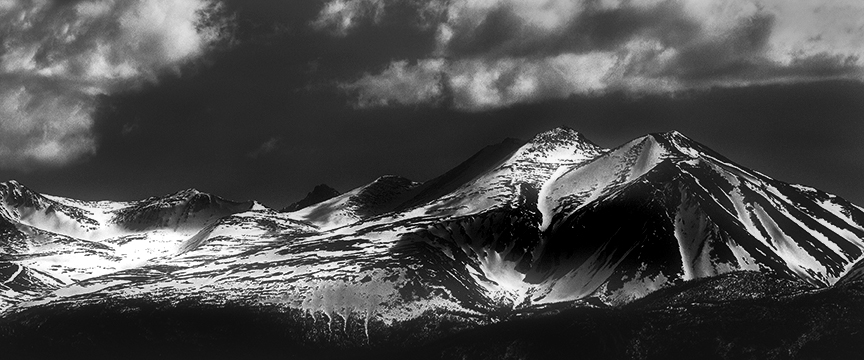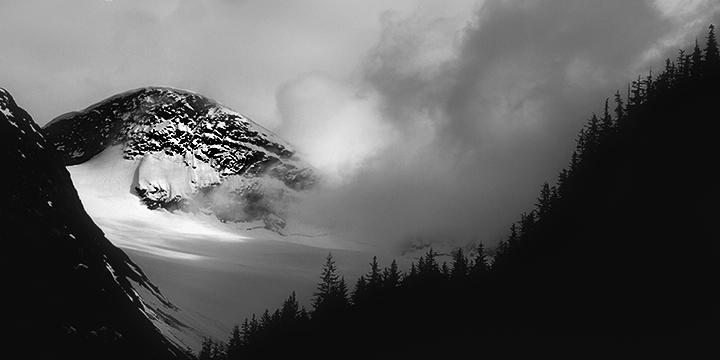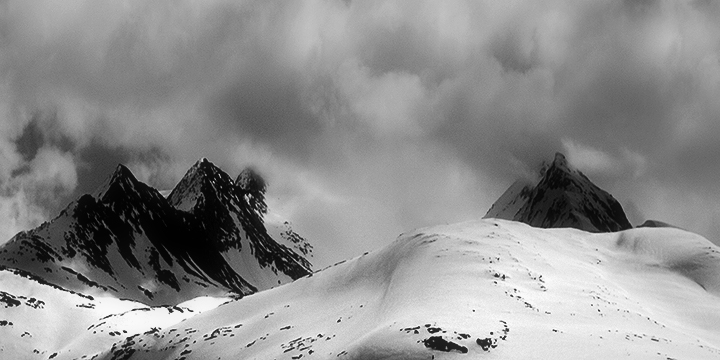When I reflect on Alaska, adjectives that immediately come to light are spectacular, colossal, magnificent and breathtaking. Such words when describing the amazing Alaskan landscapes and vistas are no overstatements, and when you personally witness the majesty of Alaska you discover that these words truly are an understatement.
The massive mountains struck by transitory light interweaving between both the gigantic ice formations and glacial water ways confirm Alaska’s visual feast and are demanding assignments for all levels of photographers.
From the very beginning of a photo workshop I was leading in Alaska, I suddenly felt the need to document the breathtaking views in Black and White. I still cannot explain the urge that seized me, but observing the awesome magnificence of the landscape, I instinctively felt that with the elimination of color, the soul of the environment would reveal itself and seduce my eye and capture my heart.
Since experiencing Alaska, photographing landscapes in Black & White is now my favored style. For me, there is something eternal yet haunting about a Black and White photograph. Where a color photograph is more animated and commands instant attention. Black & White hinges on the emotion created by the photographer and his usage of light, shadow, tone and contrast to express a mood to the viewer.
When facing a landscape, we see it in colour. By excluding colour and seeing in Black and White, the subject becomes stripped of labels, transforming the distinctive marks of the scene such as rocks, trees and mountains, into texture, lines and form. As a result, the photo turns into an interpretation instead of a factual depiction. I believe that when we view a well executed Black and White landscape photograph, we are seeing the emotional reaction and vision of the place itself, felt by the photographer.
I recently read an article from a photographer who wrote that we must move on from photographing in Black and White. He stated that we don’t see the world in Black and White and it was something done ages ago due to the limitations at the time. Contrary to his opinion, I believe there are a number of reasons why it is essential to every so often make photographs in Black and White, and how it can help develop your photographic eye.
That photographers opinion persuaded me to write in contrast to his visionless observations. When I began to compose this statement, I questioned myself on how to deliver to the reader my enthusiasm toward Black and White photography.
There are many magnificent colour photographs and still, much of my work is in colour, but when I study a Black and White photograph in contrast to colour, the Black and White divulges the purity of the light, the shadows, the composition and the many distinctive gradations of tones within the scene. Black and White photography reveals the fine art individualities of the image, the small touches that make a Black and White image notably eternal.
For me, shooting in Black and White solidified me as a straight forward shooter and I really like that. It empowers me to work with the equipment I have and transmit that into what I see and feel. I do not consider modifying a scene or a print to fit my version of how I think it ought be or to make it more interesting.
Black and White photographs have always had an mesmerizing influence on me, therefore, I photograph what I see and what my camera sees and that becomes the final print. I cannot hide behind technology to get the results I seek in my images and I am reliant on visual connection, patience and lots of optimism to craft an image.
What I strive for is to create a meaningful photograph that people recognize as a genuine moment. If this is not captured, the end result will be short of emotion and the outcome will lack authenticity.
The beauty and tranquillity of Landscapes and Nature can be very stimulating. Therefore in keeping up with the motivation of this article, I am sharing examples of Black and White landscapes from Alaska. Without color, photographers must put more prominence on lighting, composition, and context. Combined with this and the fact that there are no manufactured or man-made objects, the creation process for me became a superb source of stimulation and asisted me to see the beauty around us that we sometimes take for granted.






